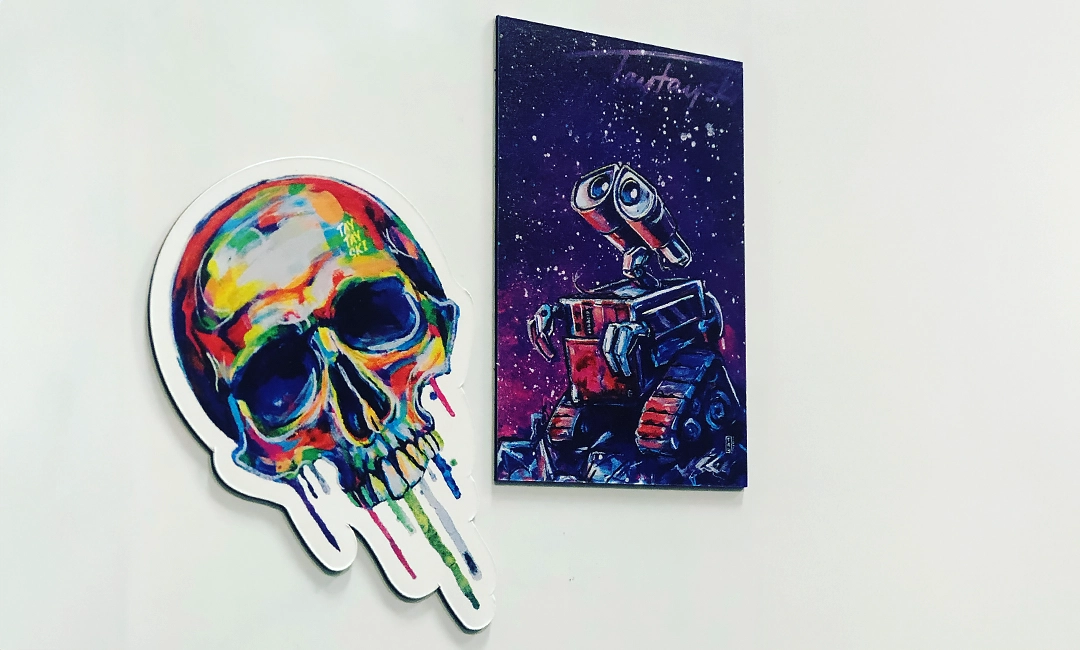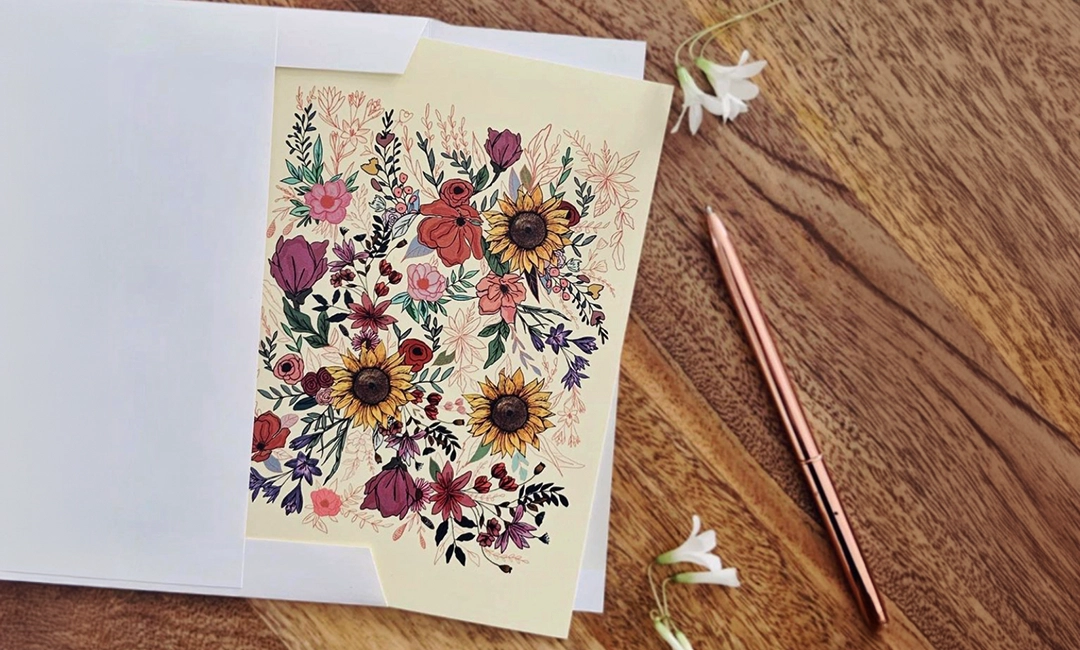Updated on August 23, 2023
Summary:
- To successfully sell your artwork online, start by digitizing it. You can do this by scanning or taking digital photographs of your pieces.
- Carefully organize and enhance your digital files for print, making use of user-friendly design tools like Canva to touch up specific visual elements.
- Decide on the products you’d like to print your artwork on—these can be as simple and straightforward as fine art prints, or as creative as coasters and postcards!
- Pick a suitable eCommerce platform through which to sell your work, such as Etsy, Shopify, or WooCommerce. Each of these platforms has its own pros and cons, so make sure you pick one that aligns with your goals and preferences.
- Actively market your online store using platforms like Instagram to keep customers aware of what you offer—and rely on trusted printers like Little Rock Printing™to guarantee consistent quality and timely delivery.
Turning your own art into print products and selling them online is a great way to start a small business or just make some extra money from your creativity—but how do you do it? Fortunately, the process has never been easier, and Little Rock Printing™ is here to show you the fastest way to get all set up.
We’ve been printing for small businesses, entrepreneurs, and artisans for years—so we know all about how you can save by ordering in bulk to increase your profit margins and more. Follow along as we go step-by-step through the process we recommend.

Step 1: Digitize Your Artwork
If you didn’t make your artwork digitally to begin with, one of the first things you’ll need to do is make a digital file out of it. There are two main ways to do this: you can either scan it (if it’s a flat image) or photograph it. We’ve provided a list of tips for both approaches here:
Scanning Your Artwork:
- Ensure the scanner is set to at least 300 DPI for clarity.
- Before placing your artwork, wipe the scanner’s glass to avoid dust or smudges.
- Align your artwork carefully on the scanner bed.
- Use the preview feature to check alignment and make adjustments.
- Use graphic software to fine-tune colors and fix imperfections.
Photographing Your Artwork:
- Natural, indirect sunlight works best. Avoid harsh shadows or glares.
- Use a tripod for stability and ensure the camera is parallel to the artwork.
- Opt for the highest resolution setting and a low ISO.
- Use manual focus to ensure sharpness, especially for detailed artworks.
- Take multiple photos from different angles to choose the best one.
- Post-process the image to adjust brightness, contrast, and color accuracy.

Step 2: Organize Your Digital Files and Prepare Them for Printing
Saving & Storing Your Files
Regardless of whether you scanned or photographed your artwork, you’ll want to make sure you save the file in a high-quality format like a TIFF or PNG to preserve its details. For more on this, read our guide on Creating High-Quality Print Files.
It’s also important to organize your digital files on your computer or in cloud storage, so they are readily accessible when needed. You’ll want to make your products as easy to replicate as possible once people start buying them!
Touching Up Your Artwork for Printing
Digitizing your artwork is about more than just uploading it to your computer. You’ll also want to use graphic design software to optimize specific elements for printing.
For those unfamiliar with more powerful tools like Photoshop or Illustrator, Canva offers a user-friendly experience. Its Pro version, priced at about $15/month, grants access to a wide range of features and templates suitable for various print products.
Learn how to make the most of Canva for any design with this list of easy Canva hacks.
Step 3: Choose Your Products
Now it’s time to decide on the products you’ll put your artwork on for people to buy. To help you get started, we’ve provided a list of option you can print with Little Rock Printing™ below:
- Greeting Cards
- Posters
- Calendars
- Die Cut Stickers
- Roll Labels
- Postcards
- Coasters
- Art Prints (if you just want to sell the artwork itself instead of putting it on a product)
Step 4: Choose Your eCommerce Platform
Selecting the right online platform is essential for the success of your art store. Here’s a breakdown of the major eCommerce options you might want to look at:
Etsy
Pros:
- Ready Audience: Etsy has a built-in customer base, particularly those looking for unique and handcrafted items.
- Ease of Use: Etsy’s user-friendly interface is ideal for those unfamiliar with setting up online stores.
- Minimal Setup: Doesn’t require domain purchasing or hosting.
Cons:
- Competition: Etsy’s a busy place, which can make it challenging for new artists to stand out.
- Fees: Listing and transaction fees can add up.
- Less Control: Limited customization options compared to other platforms.
Shopify
Pros:
- Highly Customizable: Offers a myriad of themes and plugins for customization.
- Scalability: Ideal for both beginners and those looking to expand.
- Integrated Payment Options: Simplified payment gateway integrations.
- Support: 24/7 customer support.
Cons:
- Monthly Fees: Can be more expensive due to monthly charges and certain plugin costs.
- Learning Curve: Might take some time to familiarize yourself with all features.
- Transaction Fees: Unless you’re using Shopify Payments, additional fees can apply.
WooCommerce (via WordPress):
Pros:
- Free and Open Source: Only pay for your hosting, domain, and any premium plugins.
- Highly Customizable: Thousands of plugins available for WordPress.
- Full Control: Complete control over your website and data.
- Integration: Easily integrates with WordPress sites.
Cons:
- Complexity: This choice can be overwhelming for beginners.
- Maintenance: Requires regular updates for WordPress, plugins, and themes.
- Hosting Costs: You’ll need to pay for hosting and ensure your host can handle your store’s demands.
- Security: Since WooCommerce is self-hosted, you’re responsible for your site’s security measures.
Other Platforms to Consider
- BigCommerce: Known for its flexibility and scalability, but might be overkill for small artists or beginners.
- Wix: Easy to use with drag-and-drop features but less powerful than dedicated eCommerce platforms.
- SquareSpace: Great for artists wanting a beautiful site without much hassle but less flexibility in advanced eCommerce features.
Ultimately, you’ll want to make your choice based on your tech-savviness, budget, and long-term vision for your art business.

Step 6: Market and Promote Your Store
Once you set up your store, it’s time to put the spotlight on your art and attract buyers. Try these strategies:
- Share on Social Media: Use visual platforms like Instagram to showcase your work and connect with art enthusiasts.
- Email Marketing: Build a subscriber list and send regular newsletters, highlighting new pieces and offers.
- Collaborate: Team up with fellow artists or brands for joint promotions or art showcases.
- SEO & Content Marketing: Optimize your store for search engines and craft engaging art-related content.
- Paid Advertising: Try using Facebook Ads or Google AdWords to broaden your reach and attract potential buyers.
- Engage with Art Communities: Participate in art fairs or online forums to network and gain exposure.
- Continuous Creation: Regularly update your store with fresh artwork, and consider offering occasional promotions.
- Customer Feedback: Encourage reviews from satisfied buyers and use feedback to refine your shop.
This might sound like a long to-do list, but consistently applying these tips can transform your online store from a quiet gallery into a bustling marketplace for your art.
Getting Reliable Prints of Your Art with Little Rock Printing™
The most important part of having a successful online store is to keep products with your artwork in stock—and Little Rock Printing™ can help you make this process seamless. Since we personally oversee the printing of our orders, have no minimum order sizes, and guarantee our delivery timelines, you can rest assured that you’ll never have to worry about supply chain or quality control issues with us.
Best of all, ordering prints from us is easy! Just go to the pages for the products you need, drag-and-drop your print-ready design files into the uploader, and submit your order. You can also customize your order based on paper type, finish, and size—giving you more options to offer your customers! Don’t forget to contact us if you have any questions; we’re always standing by and ready to assist.
Frequently Asked Question About Printing & Selling Original Art Online
Why choose Little Rock Printing™ over drop shipping?
Drop-shipping is where you rely on a third party to produce the products your artwork will be printed on and ship them directly to your customers. At first, this might seem easier than ordering print products yourself—but there are a few potential hurdles you need to know about before you gamble on this method:
- Quality Control: Little Rock Printing™ ensures a hands-on approach to every order, prioritizing precision and quality. With drop shipping, you might not see the product before it reaches the customer, leading to potential errors and inconsistencies.
- Customer Service: Little Rock Printing™ personally oversees your order, so we’re there to help you with any concerns or special requests you have. Drop shipping often involves a third-party middleman, which can lead to communication barriers.
- Turnaround Times: Little Rock Printing™ offers guaranteed timelines that you select when you place your order. Since drop shipping often requires coordination between multiple parties, there can sometimes be delays caused by supply chain issues or other logistical problems.
- Customization and Branding: Our team at Little Rock Printing™ understands the importance of branding for artists. We offer a range of customization options for all print products, from paper type and finish to unique packaging that resonates with your brand. If you use drop shipping, these branding elements might be generic or limited.
- Cost-Effective: While drop shipping might seem cost-effective initially, hidden costs like membership fees or markups on products can add up. Little Rock Printing™ offers transparent pricing, ensuring that you get the best value for your investment.
So while drop shipping might seem convenient, partnering with a dedicated printing service like Little Rock Printing™ ensures that you retain control over your quality, branding, and overall customer experience. These factors can have a significant impact on the success of your shop.
Do I need professional equipment for photographing my art?
Probably not—while professional cameras might offer more control over settings, modern smartphones are sufficient for capturing high-quality images of your artwork. For best results, use a neutral background and make sure your artwork is properly lit to avoid shadows.
How should I price my art products?
Pricing your art products involves a delicate balance of various factors to ensure you’re covering costs while also remaining competitive and profitable. Here’s a simple guide to help you determine the right price for your creations:
- Production Costs: Factor in materials, printing, packaging, and any other direct costs related to producing your products.
- Perceived Value: How unique or intricate is your art? The more distinct or complex, the more people will probably pay for it.
- Competitor Pricing: Research similar artists or products to understand the general pricing landscape. This will give you a ballpark figure and ensure you’re not undervaluing or overpricing your work.
- Profit Margin: Ensure you’re not just covering costs but also making a reasonable profit to sustain and grow your business.
- Shipping and logistics: To make sure shipping costs don’t eat into your profits, you’ll want to figure out how much it costs to ship to each of the different areas where you’ll make your products available and then work these into the final price.
You should also periodically revisit and adjust your pricing—these factors change over time!
What if my digital art doesn’t match the printed version?
This discrepancy could be due to differences in screen calibration and print settings. Always request a sample print from Little Rock Printing™ before ordering in bulk—you can do this by placing an order for a single unit of your item with us and entering the code “FREEPROOF” at checkout!
Can I offer custom art products on demand?
Most likely! Many platforms (including Etsy) allow artists to offer custom orders so their customers can get personalized products. Just make sure you’re able to fulfill these requests by partnering with flexible printers like us who can provide these options and work with you on the little details!








